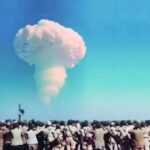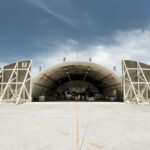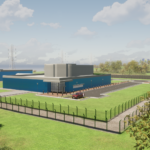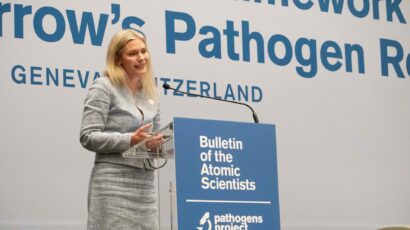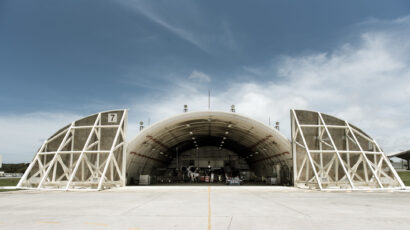When could Iran deliver a nuclear weapon?
By Richard L. Garwin | January 17, 2008
The traditional concern about Iran’s capability to deliver a nuclear weapon involves an Iranian ballistic missile that could reach the United States from Iran. Therefore, in this piece I describe the current state and expected time when Iran could achieve these capabilities on the basis of recent statements by U.S. government officials, the unclassified portion of the December 2007 Iran National Intelligence Estimate, and data from an April 2006 interview with the head of Iran’s Atomic Energy Organization.
But Iran could far sooner deliver a nuclear weapon against U.S. coastal cities by using short-range ballistic or cruise missiles fired from a ship near U.S. shores. Such missiles would be more accurate and carry a heavier payload than an Iranian intercontinental ballistic missile (ICBM).
Missiles
In his speech to the National Defense University on October 23, President George W. Bush made clear his intention to deploy ballistic missile defense in Europe: “Our intelligence community assesses that, with continued foreign assistance, Iran could develop an intercontinental ballistic missile capable of reaching the United States and all of Europe before 2015, if it chooses to do so, and the international community does not take steps to prevent it, it is possible Iran could have this capability. And we may need to take it seriously–now.”
Further, he termed the radar in the Czech Republic and the interceptors to be deployed in Poland as “limited in scope. It is not designed to defend against an attack from Russia. The missile defenses we can employ would be easily overwhelmed by Russia’s nuclear arsenal.”
He continued, “As part of the new relationship, we’re inviting Russia to join us in this cooperative effort to defend Russia, Europe, and the United States against an emerging threat that affects us all.”
He opened the door to include the proffered radar facilities in Azerbaijan and southern Russia “as part of a wider threat-monitoring system that could lead to an unprecedented level of strategic cooperation between our two countries.”
The speech was carefully crafted, and the words of Defense Secretary Robert Gates were also carefully chosen when Gates spoke the same day as Bush during a press conference with Czech Prime Minister Mirek Topolanek: “Secretary [of State Condoleezza] Rice and I put two additional proposals before the Russians. One of them I’ve described to you in terms of looking for additional ways for transparency by providing a Russian presence. Again, anything along those lines that we would develop would be presented to the Czech government first, and we would not go forward without the approval of the Czech government.
“The second proposal was that we would consider tying together the activation of the sites in Poland and the Czech Republic with definitive proof of the threat; in other words, Iranian missile testing and so on. We have not fully developed this proposal, but the idea was we would go forward with the negotiations–we would complete the negotiations, we would develop the sites, build the sites, but perhaps would delay activating them until there was concrete proof of the threat from Iran.”
Note that the deployment will go ahead, but “perhaps” we would delay their activation.
As for the imminence and certainty of the Iranian threat, nothing could support it less than Bush’s rather precise characterization. “Could,” “it is possible,” and “may” do not demand urgency in deploying missile defenses in Europe.
In 1998, I served on the nine-person Commission to Assess the Ballistic Missile Threat to the United States (better known as the “Rumsfeld Commission”); it had a strikingly similar characterization of the Iranian threat: “We judge that Iran now has the technical capability and resources to demonstrate an ICBM-range ballistic missile, similar to the TD-2 [the North Korean Taepodong-2 missile, which is based on scaled-up Scud technology] within five years of a decision to proceed–whether that decision has already been made or is yet to be made.”
Our report was issued on July 15, 1998, and its unclassified executive summary contains all the important observations and recommendations of the highly classified report.
According to our commission, which, by law, had access to all of the U.S. intelligence material, if Iran wanted an ICBM, such a missile could have been operational in 2003. Not only did Iran not achieve this capability in 2003, but with the same assumptions, according to current intelligence assessments, it could only achieve the capability now by 2015 at the earliest.
So why the urgency to deploy the radar in the Czech Republic and 10 interceptors in Poland? And what is the credibility of the commitment to deploy only 10 interceptors in Poland? President Bill Clinton took the decision to be ready to deploy a ballistic missile defense against rogue states, initially with 20 interceptors total, to defend the United States against missiles that might come from North Korea, Iran, or perhaps, Iraq. But in October 1999, after criticism from Republicans that even the loathsome 1972 Anti-Ballistic Missile Treaty permitted 100 nuclear-armed interceptors and without even arguing that the threat had increased, the Clinton administration upped the initial deployment to 100 interceptors, with potential growth to 200 or 250.
On my website, many articles going back to my March 1968 Scientific American piece with Hans Bethe (“Anti-Ballistic Missile Systems”) explain the ineffectiveness of midcourse intercept of ICBMs–the kind of defensive system now planned for deployment in Poland. The argument is simple. Observations of the objects as they fall through space toward their targets in the United States cannot distinguish between light aluminum-foil clad balloons and real warheads, especially when the warheads are enclosed by similar balloons, and it is simple for the missile to deploy many such balloons as soon as it leaves the atmosphere and the rocket engines stop firing. To counter this threat, the defense must deploy vastly more interceptors than missiles, or it must consider the defense ineffective unless it modifies the defensive system in order to handle them.
When Donald Rumsfeld and I appeared on the NewsHour with Jim Lehrer in 1998, we were questioned about the advisability of defenses against the missile threat. We both responded that our commission had not discussed defenses. Rumsfeld volunteered that he hadn’t studied the problem, but his uninformed personal view was to favor the deployment of such a defense because we had no protection against missiles, in contrast, for instance, to an annual expenditure of billions of dollars to control our borders.
In contrast, I had long studied the issue for the U.S. government, and I indicated that a defense that did not take simple countermeasures into account would be worse than no defense at all. Furthermore, I stated, the Rumsfeld Commission was quite clear that any of the countries that might pose a threat to the United States with nuclear weapons or biological weapons on ICBMs could far sooner pose a greater threat by firing short-range ballistic missiles or cruise missiles from ships within 100 miles or so of U.S. shores. The shorter-range missiles have more payload capacity and are tried-and-true, although some might have to be adapted to shipboard launch.
We had then–and we have now–no defense against such short-range missiles attacking U.S. cities; nor do we have a program to deploy such a defense.
As for Bush’s observation that hundreds of Russian missiles and thousands of Russian warheads could easily overwhelm the European defense, it’s certainly true. But neither Russia nor the United States wants to be denied the option of using a few ICBMs. Last summer, the U.S. Missile Defense Agency (MDA) made a sweeping argument that the interceptors in Poland were incapable of intercepting even one Russian ICBM. In their enthusiasm to prove it, their illustration built in an inexplicable delay of 250-300 seconds between the firing of a Russian ICBM and the launch of an interceptor, despite authoritative studies (e.g., one by the American Physical Society that took seriously systems in which the interceptor was fired 50 or 100 seconds after missile launch. I have discussed this more thoroughly in an August 2007 presentation.
As for Iran’s nuclear weapon capability, in a still-secret August 2005 National Intelligence Estimate (NIE), the U.S. intelligence community is reported to have judged, “Left to its own devices, Iran is determined to build nuclear weapons.” But the 2005 NIE thought it unlikely that Iran could produce enough highly enriched uranium (HEU) for a bomb before “early to mid-next decade.”
On this point, John Negroponte, the former director of U.S. national intelligence, stated in a 2006 BBC interview, “We don’t have clear-cut knowledge. But the estimate that we have made is that sometime between the beginning of the next decade and the middle of the next decade, Iran might be in a position to have a nuclear weapon.”
Of course, U.S. national missile defense does nothing to protect against an Iranian nuclear weapon delivered by ship or short-range missile, so the MDA and Bush focus on the potential advent of Iranian long-range missiles in 2015. But how relevant to U.S. national security is that missile defense against long-range missiles?
Seven years after the publication of the 2000 independent report “Countermeasures: A Technical Evaluation of the Operational Effectiveness of the Planned U.S. Missile Defense System”, MDA Director Trey Obering, addressed the decoy question in a DefenseNews article entitled, “Missile Defense Hits Mark”: “And the multiple kill-vehicle system is a generational upgrade to the land- and sea-based midcourse interceptors that will allow us to handle decoys and countermeasures.” But Obering suggests that the multiple kill vehicles will be available in 2014 or 2015, entirely compatible with my claim that by the time Iran or North Korea deploys a long-range missile, they will have effective balloon decoys that cannot be discriminated and, apparently, must all be intercepted.
I am sure that it will be news to many missile defense supporters, who have uncritically accepted the administration’s claims that it is deploying a system that will be effective against early models of the Iranian or North Korean ICBMs, to now find that the MDA is belatedly accepting the fact that the system that they have been buying (and selling to Congress and the public) for many years will not work without an upgrade that is only now in conceptual form.
Nuclear warheads
On December 3, 2007, the National Intelligence Council (NIC) published another NIE on Iran. The unclassified version, “Iran: Nuclear Intentions and Capabilities,” presents “key judgments” and a comparison of the 2007 NIE with the May 2005 assessment. (The May 2005 assessment is not otherwise publicly available.) Here are three summary paragraphs from the 2007 NIE:
“Judge with high confidence that in fall 2003, Tehran halted its nuclear weapons program. Judge with high confidence that the halt lasted at least several years. ([The Energy Department] and the NIC have moderate confidence that the halt to those activities represents a halt to Iran’s entire nuclear weapons program.) Assess with moderate confidence that Tehran had not restarted its nuclear weapons program as of mid-2007, but we do not know whether it currently intends to develop nuclear weapons. Judge with high confidence that the halt was directed primarily in response to increasing international scrutiny and pressure resulting from exposure of Iran’s previously undeclared nuclear work. Assess with moderate-to-high confidence that Tehran at a minimum is keeping open the option to develop nuclear weapons.
“We judge with moderate confidence that the earliest possible date Iran would be technically capable of producing enough highly enriched uranium for a weapon is late 2009, but that this is very unlikely. We judge with moderate confidence that Iran probably would be technically capable of producing enough HEU for a weapon sometime during the 2010-2015 time frame. ([The State Department Bureau of Intelligence and Research, or INR] judges that Iran is unlikely to achieve this capability before 2013 because of foreseeable technical and programmatic problems.)
“All agencies recognize the possibility that this capability may not be attained until after [emphasis in the original] 2015.”
By “nuclear weapons program,” the NIE is describing “Iran’s nuclear weapon design and weaponization work and covert uranium conversion-related and uranium enrichment-related work; we do not mean Iran’s declared civil work related to uranium conversion and enrichment.”
We now leave the 2007 Iran NIE. Since 2006, the International Atomic Energy Agency (IAEA) has been monitoring Iran’s civil work; thus, it is in a position to verify Iran’s statements to the IAEA as to its centrifuge plant and its enrichment activity. Iran maintains that it is producing 3.5-percent uranium 235 (U-235) and not the 90-percent U-235 product desirable for a nuclear weapon. In public statements (for instance, in an April 2006 interview on Tehran Vision, Network 2), Gholamreza Aqazadeh, head of Iran’s Atomic Energy Organization, gave detailed information about the performance of the 164-centrifuge cascade that is the basis of the Natanz installation, where Iran has announced that 3,000 centrifuges are now operating. From Aqazadeh’s interview, we can infer the performance of the centrifuges as they are configured in this cascade. (In their November 2007 Arms Control Today article, “A Witches’ Brew? Evaluating Iran’s Uranium-Enrichment Progress,” David Albright and Jacqueline Shire provide a more historical view of the progress of Iran’s enrichment activity. Because their article appeared before the 2007 NIE, they could not take it into account. The present piece provides a more technical analysis of the 164-machine centrifuge module. In particular, a firm judgment is made that the tails concentration of U-235 is 0.40 percent.)
For what follows, it may be helpful to refer to this table–a live Excel spreadsheet, which can be viewed or downloaded from my website.
In the interview, Aqazadeh said, “In the 164 chain, the maximum amount of material that we can feed the system is 70 grams an hour, with a 10-percent product of 7 grams. The product is 7 grams. Some 93 grams remain. [He apparently means 63 grams.] When a series is operating 24 hours you have to multiply 24 by 70 grams. This is the total product of one series.”
He states that the U-235 content of the feed is 0.71 percent (normal uranium) as uranium hexafluoride and that product is 3.5-percent U-235. The “63 grams” that remain are “waste”–or “tails” in the terminology of uranium enrichment. The interview is totally ambiguous as to whether the 70 grams per hour feed is the mass of uranium or the mass of uranium hexafluoride. If it is 70 grams per hour of uranium hexafluoride, the mass of uranium must in every case be multiplied by 0.676. We assume that Aqazadeh was stating masses of uranium.
From the interview, we can also infer that the 164-centrifuge cascade has 24 centrifuges in parallel at the feed stage and a total of 15 stages; there are 10 enrichment stages and 6 “stripper” stages–both the “10” and the “6” including the feed stage of 24 centrifuges. The final enrichment stage has only a single centrifuge, where an “ideal cascade” might demand slightly less than one or slightly more than one machine. This “squared-off” cascade is thus less efficient than the ideal cascade.
Because precisely as much U-235 emerges in the product and waste streams as is fed to the cascade, it is easy to see that the waste stream has 0.4-percent U-235 content. Of the initial U-235, or 0.497 grams per hour (0.71 percent multiplied by 70 grams per hour), the product contains 0.245 grams per hour of U-235 (3.5 percent multiplied by 7), or 49.3 percent of the total, with 50.7 percent going to the waste stream.
Thus, one such 164-centrifuge cascade could produce 2.148 kilograms per year of U-235 (0.245 grams per hour multiplied by 24 hours per day multiplied by 365.25 days per year) in 61.4 kilograms of 3.5-percent low-enriched uranium (LEU). Then 18 cascades would contribute 1.105 tonnes per year of LEU (one tonne is 1,000 kilograms). A standard 1,000-megawatt reactor burns about 1 tonne of U-235 per year (in LEU), and thus, would require the full-time output of 75,424 centrifuges (1,000 kilograms per year divided by 2.148 kilograms per year equals 466 164-centrifuge cascades). Since the centrifuge hall at Natanz is to contain 50,000 centrifuges, even 100-percent operation will not produce enough LEU to sustain the Bushehr reactor about to be put into operation–with Russian-supplied fuel.
Although the “3,000” centrifuges said to have been operating at Natanz by fall 2007 could make only a tiny contribution to fueling a power reactor, the same is not true of enrichment for a nuclear weapon. The theory governing a cascade of identical enrichment devices was developed for the Oak Ridge enrichment plant built during World War II for the nuclear weapon that destroyed Hiroshima. That weapon needed about 60 kilograms of HEU that we can assume to be 90-percent U-235. Later “implosion” weapons required an IAEA “significant quantity” of 25 kilograms of HEU, approximately 20 kilograms of U-235. Obviously, for HEU production, Iran’s centrifuges must be connected in an arrangement other than the 164-machine building block used for LEU.
Without going into detail as to the shape of the ideal cascade that might produce 90-percent U-235–fed with 0.71-percent U-235 feed (natural uranium) and with a waste stream containing 0.4-percent U-235–it is simple to determine the HEU output rate of these 3,000 centrifuges. The computation makes use of the “separative work” output of one of these centrifuges, which, in turn, can be calculated from the separative work demanded in the production of 1.105 tonne per year of 3.5-percent LEU. This can be determined in a standard fashion from the “value function” of 1 kilogram of 0.71-percent feed, of 3.5-percent product, and of 0.4-percent waste, multiplied by the mass of each per year. (For an introduction to separative work units (SWU) and the value function, see the Federation of American Scientists’ SWU calculator. See also my SWU calculations spreadsheet, as well as other useful fuel-cycle calculators.)
For these parameters (Row 12 of the table), each kilogram of 3.5-percent product represents 3.64 SWU, and each centrifuge contributes equally to the 4,022 SWU per year (3.64 multiplied by 1,105) required for 1,105 kilograms of 3.5-percent LEU. Since there are 2,952 machines (18 multiplied by 164), each centrifuge is contributing 1.362 SWU per year (4,022 divided by 2,952). The SWU output of a single centrifuge would be somewhat higher because some of the output is wasted by the real squared-off cascade instead of an ideal cascade. If we assume that the efficiency will be comparable in the cascade connection for HEU, the HEU production rate is calculated from the SWU requirement per kilogram of 90-percent HEU. With natural uranium feed and 0.4-percent U-235 in the waste stream, each kilogram of 90-percent product requires 170.4 SWU (row 11). The 4,022 SWU per year output of 2,952 centrifuges thus corresponds to the production of 23.6 kilograms per year of 90-percent HEU (4,022 divided by 170.4).
If Iran could operate its 3,000 installed centrifuges at the rate claimed for the 164-machine cascade in 2006, it could produce enough HEU for one implosion weapon each year. There is no reason to believe that Iran could not install 3,000 (or even 10,000) more centrifuges in 2008, at the end of which, it could be producing HEU for two to four bombs per year. And the full 50,000 centrifuges planned for Natanz could produce 400 kilograms of HEU per year–enough for about 20 bombs each year.
One bomb with 25 kilograms of 90-percent HEU would require 7.23 tonnes of natural uranium feed (289 multiplied by 25); the Aqazadeh interview states that as of April 2006, Iran had produced some 110 tonnes of uranium hexafluoride containing about 78 tonnes of uranium–enough for 10 bombs. Iran’s plants for processing uranium ore to uranium hexafluoride have not been idle. For a Hiroshima-type bomb, about three times as much HEU is needed, so the bomb production rate would be a factor 3 lower.
According to the 2007 Iran NIE, “INR judges that Iran is unlikely to achieve this capability (one weapon’s worth of HEU) before 2013 because of foreseeable technical and programmatic problems.” The INR has a good record–and in this case they may be relying on intelligence that has not been revealed in the 2007 NIE–but the above analysis shows how far from a nominal performance Iran’s centrifuges must fall, to fail to produce HEU for nuclear weapons within a year after the action is taken to rearrange the plumbing at Natanz or to install 3,000 centrifuges at some hidden location.
Furthermore, if the decision to build nuclear weapons is delayed for a year or two, there is another option besides turning the enrichment capacity to producing HEU with a feed of natural uranium. The accumulated 3.5-percent LEU could be used in a reconfigured or separate plant to produce HEU containing 90-percent U-235, with waste at 0.40-percent U-235 (row 20). The benefit is the greatly increased production rate of a 3,000-centrifuge module when fed with 3.5-percent U-235. Each kilogram of 90-percent product requires only 65.33 SWU rather than the 170.6 SWU required to produce 90-percent HEU from natural uranium feed. Thus, 3,000 centrifuges configured in an optimum real cascade for the production of HEU with LEU feed, can produce 61.6 kilograms of HEU per year (4,022 divided by 65.33)–almost three times what it could produce from natural uranium feed. This would be about one gun-type bomb or three implosion-type bombs per year.
Conclusion
The potential Iranian threat of nuclear weapon delivery against the continental United States should not be viewed through the distorted lens of the Bush administration’s priority to deploy a so-called defense against ICBMs. Nor should we put confidence in an arbitrary distinction between an Iranian civil program and a “nuclear weapon program.”
Although Iran’s supreme leader has stated that Iran won’t build nuclear weapons because of religious prohibitions, new interpretations of religious proscriptions and demands may lead to a nuclear weapon capability at a rate determined by capabilities and not current professed intentions. That said, I believe it entirely contrary to fundamental principles of U.S. behavior to argue that Iran (or other countries) must not be allowed to “acquire knowledge” as to how to enrich uranium. This is also contrary to U.S. commitments under the Nuclear Non-Proliferation Treaty (NPT).
In the United States, we need to openly discuss where Iran has violated the NPT–by failing to notify the IAEA of activities that would have been permitted under the NPT had they been fully disclosed. More recently, the evidence presented in the 2007 NIE that Iran definitely possessed a secret program to acquire nuclear weapons constitutes a much more serious charge than failing to notify the IAEA of otherwise permitted activities. In general, the NPT needs an Additional Protocol that would force a non-nuclear weapon state member that leaves the treaty to destroy or return the materials and facilities acquired as an NPT member. And that this obligation survives cessation of membership in the NPT. Such an approach would legitimize a much more muscular response to situations such as that in Iran.
Together, we make the world safer.
The Bulletin elevates expert voices above the noise. But as an independent nonprofit organization, our operations depend on the support of readers like you. Help us continue to deliver quality journalism that holds leaders accountable. Your support of our work at any level is important. In return, we promise our coverage will be understandable, influential, vigilant, solution-oriented, and fair-minded. Together we can make a difference.
Topics: Nuclear Weapons, Opinion


